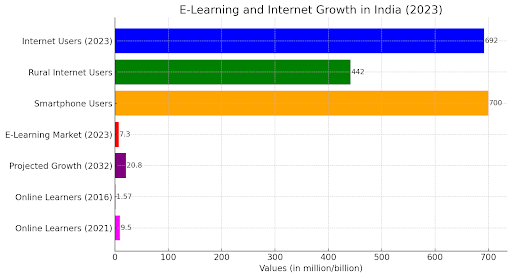The rapid evolution of technology has significantly impacted various aspects of human life, and education is no exception. The Digital India Initiative, launched in 2015, aims to transform India into a digitally empowered society and knowledge economy. This ambitious program has significantly impacted the education sector by promoting digital infrastructure, digital literacy, and the delivery of educational services through digital means. One of the most profound effects has been the rise of e-learning, which is revolutionizing how students across the nation access and engage with educational content.
With the widespread availability of the internet, the increase of affordable smartphones, and increasing government initiatives, digital learning is breaking barriers and bridging gaps in education. Whether through online courses, virtual classrooms, or interactive e-learning platforms, the digital revolution is making education more accessible, personalized, and engaging. This article explores the transformative power of e-learning, its evolution, government initiatives, benefits, challenges, and the future of digital education in India.
What Is E-Learning?
E-learning, refers to the use of digital platforms and tools to deliver educational content outside traditional classrooms. It encompasses online courses, virtual classrooms, and digital resources that facilitate learning through electronic devices such as computers, tablets, and smartphones.
This mode of education offers multiple advantages, including flexibility, accessibility, and personalized learning experiences, making it a viable alternative to conventional teaching methods. Unlike traditional education, which relies on physical infrastructure and face-to-face interactions, e-learning leverages technology to create an interactive and immersive educational experience.

The Evolution Of E-Education In India
India’s educational landscape has undergone a significant transformation, moving from traditional chalk-and-board classrooms to digital learning spaces. The rapid increase in internet penetration and the affordability of smart devices have facilitated this shift.
Earlier, students depended heavily on physical textbooks and classroom-based teaching. However, with the rise of e-learning platforms, students now have access to high-quality educational content, expert-led video tutorials, real-time virtual classrooms, and AI-driven personalized learning solutions. This transformation has democratized education, allowing learners from diverse backgrounds to benefit from digital resources irrespective of their geographical location.
The shift towards digital education has been further accelerated by the COVID-19 pandemic, which forced schools and universities to adopt online learning. As a result, e-learning has now become a mainstream method of education rather than just an alternative.
Impact Of Covid-19 On E-Learning Adoption In India
| Sr. No | Key Factors | Pre-COVID (Before March 2020) | Post-COVID (March 2020 & Beyond) |
|---|---|---|---|
| 1 | Surge in Online Learners | ~45 million online learners (2019) | 90+ million online learners (2021) – nearly doubled |
| 2 | Increased EdTech Investments | ~$500 million investment in 2019 | ~$4.7 billion investment by 2021 (10x growth) |
| 3 | Growth in Internet Penetration | ~50% internet penetration (~600 million users) | ~65% internet penetration (~900 million users in 2023) |
| 4 | Pre vs. Post-COVID E-Learning Adoption | Limited to urban areas & higher education | Mass adoption across schools, colleges & professional learning platforms |
| 5 | Growth of EdTech Startups | ~4,500 EdTech startups | 6,500+ EdTech startups by 2022 |
| 6 | Government Initiatives | Existing platforms like SWAYAM, DIKSHA | Expansion of digital education policies under 'Digital India' |
How The Digital India Initiative Is Fueling E-Education
The Indian government has played a crucial role in promoting e-learning by launching various initiatives under the Digital India program. These initiatives are aimed at enhancing digital infrastructure, equipping educators with technological skills, and providing students with accessible and high-quality digital content. Some of the most significant programs include:
01.
Swayam
SWAYAM (Study Webs of Active Learning for Young Aspiring Minds) is an online platform that offers a wide range of courses, from school education to postgraduate studies. This initiative aims to bridge the digital divide and provide access to quality education to students who were previously left out of the digital revolution. The platform features interactive learning modules, video lectures, and self-assessment tools, making education more engaging and comprehensive.
02.
Diksha
Diksha is a digital infrastructure designed for teachers. It provides training modules, teaching resources, and assessment tools to help educators improve their teaching methodologies. With an extensive library of lesson plans, multimedia content, and quizzes, Diksha empowers teachers to create a more interactive and effective learning experience for students.
03.
E-Pathshala
E-Pathshala is an initiative by the National Council of Educational Research and Training (NCERT) that offers digital resources, including textbooks, audio, video, and other learning materials for students, teachers, and parents. It ensures that quality educational content is available in multiple formats and languages to serve to a diverse audience.
Additionally, programs like BharatNet are connecting rural areas to high-speed internet, ensuring that digital education reaches even the remotest parts of the country. Technological advancements such as Artificial Intelligence (AI), Augmented Reality (AR), and Virtual Reality (VR) are further enhancing the e-learning experience by making it more immersive and interactive.
Mobile Vs. Desktop Learning: Data Comparison
| Sr. No | Category | Mobile Learning 📱 | Desktop Learning 💻 |
|---|---|---|---|
| 1 | Engagement Time per Session | 10-25 minutes (short bursts) | 30-60 minutes (longer focus) |
| 2 | Preferred Learning Style | Microlearning, interactive content | In-depth learning, detailed courses |
| 3 | User Demographics | Younger students, professionals on the go | University students, corporate employees |
| 4 | Ease of Access | High (anytime, anywhere) | Medium (requires a fixed setup) |
| 5 | Content Format Preference | Videos, quizzes, podcasts | PDFs, research papers, detailed modules |
| 6 | Learning Effectiveness | High for short-term retention | High for deep understanding |
| 7 | Distraction Level | Higher (notifications, multitasking) | Lower (dedicated learning environment) |
| 8 | Completion Rate of Courses | Lower (prone to interruptions) | Higher (better focus & commitment) |
| 9 | Best for | Quick skill-building, revision | Full-course learning, certifications |
| 10 | Challenges | Small screen size, potential distractions | Less portable, requires setup |
The Benefits Of Digital Education
E-learning offers numerous advantages over traditional education, making it a preferred choice for students, educators, and institutions alike. As technology continues to evolve, digital education is becoming increasingly accessible, interactive, and effective in fostering academic growth. Below are some of the key benefits of digital education:

Accessibility
One of the most significant advantages of e-learning is its ability to provide education to students in remote and rural areas. Digital learning eliminates geographical barriers, allowing students to access quality educational content without the need to relocate or commute long distances. Additionally, e-learning platforms often support multiple languages, enabling students from diverse backgrounds to engage in courses in their preferred language. For individuals with disabilities, assistive technologies such as screen readers, voice recognition, and subtitles ensure an inclusive learning environment.
Cost-Effectiveness
E-learning significantly reduces the costs associated with physical infrastructure, textbooks, and travel. Many online courses are free or available at a lower cost compared to traditional classroom education, making learning more affordable for students from all economic backgrounds. Institutions also benefit from reduced operational costs, allowing them to allocate resources to improve the quality of education. Moreover, digital libraries and open-source materials reduce the dependency on expensive textbooks, further lowering financial barriers to education.
Personalized Learning
AI-driven e-learning platforms can tailor educational content to individual learning styles and paces. This personalized approach enhances the overall learning experience by catering to students' specific needs and helping them grasp complex concepts more effectively. With adaptive learning algorithms, students receive customized recommendations, ensuring they focus on areas that require improvement. Personalized feedback mechanisms further enhance their learning journey, enabling continuous progress assessment and targeted support.
Flexibility And Convenience
Unlike traditional classrooms with fixed schedules, e-learning allows students to learn at their own pace and convenience. This flexibility is particularly beneficial for working professionals, students pursuing multiple courses, and individuals with other commitments. Online courses often provide recorded lectures, allowing learners to revisit lessons anytime. This self-paced learning model accommodates various learning speeds and schedules, promoting better time management and productivity.
Interactive And Engaging Content
Digital education leverages multimedia elements such as videos, animations, quizzes, and simulations to make learning more engaging. This interactive approach enhances retention and understanding, making education more enjoyable for students. Gamification techniques, such as badges, leaderboards, and rewards, further motivate learners to actively participate in their studies. Virtual and increased reality technologies bring complex subjects to life, allowing students to explore immersive learning experiences beyond traditional textbooks.
Real-Time Feedback And Assessment
E-learning platforms provide instant feedback through quizzes, assignments, and automated assessments. This immediate feedback mechanism allows students to identify their strengths and weaknesses in real time, helping them focus on areas that need improvement. Educators also benefit from data-driven insights, enabling them to track student progress and customize teaching methods accordingly.
Environmental Benefits
Digital education contributes to environmental sustainability by reducing the need for paper, transportation, and physical infrastructure. E-learning minimizes carbon footprints by cutting down on travel emissions and decreasing the demand for printed materials. As educational institutions increasingly adopt paperless practices, digital learning becomes an eco-friendly alternative to traditional classroom-based education.
Challenges And The Road Ahead
Despite its numerous benefits, digital education in India faces several challenges that must be addressed for widespread and effective adoption. Overcoming these barriers will require a multi-pronged approach involving policy interventions, infrastructure development, teacher empowerment, and content quality assurance.
01. Digital Divide
While internet penetration in India has grown significantly, there remains a stark divide in digital access between urban and rural areas. Many students in remote locations struggle with unreliable internet connectivity, lack of affordable devices, and limited access to electricity. Additionally, economically weaker sections find it challenging to afford the hardware and data required for uninterrupted learning.
To bridge this gap, both government and private stakeholders must invest in improving digital infrastructure, expanding broadband connectivity, and introducing affordable learning devices. Initiatives such as public Wi-Fi hotspots, subsidized tablets, and partnerships with telecom providers for cost-effective data plans can help democratize digital education.


02. Teacher Training
The success of digital education largely depends on teachers’ ability to effectively use technology to facilitate learning. However, many educators, particularly in traditional classroom settings, lack the necessary training and confidence to adopt digital teaching methodologies.
Comprehensive training programs must be implemented to equip teachers with essential digital skills, including content creation, interactive learning tools, and student engagement strategies. Governments and ed-tech companies should collaborate to provide continuous professional development, ensuring that educators can adapt to evolving technologies and teaching methods.
03. Quality Assurance
With the rapid proliferation of online courses, mobile learning apps, and digital education platforms, maintaining quality and credibility is a pressing concern. Without proper regulatory oversight, students may be exposed to wrong content, misleading certifications, and ineffective teaching methods.
Establishing well accreditation mechanisms and quality benchmarks for e-learning platforms is crucial. Regulatory bodies must define clear standards for course content, assessment methodologies, and instructor qualifications. Additionally, integrating student feedback systems and leveraging AI-driven analytics can help monitor course effectiveness and improve learning outcomes.


04. Data Privacy And Cybersecurity Concerns
As digital education relies on online platforms, safeguarding student data and maintaining cybersecurity is a growing concern. Many e-learning platforms collect sensitive student information, making them vulnerable to cyber threats and data breaches.
It is essential to implement stringent data protection policies, ensure compliance with privacy laws, and educate students and teachers about cybersecurity best practices. Secure login systems, encrypted databases, and AI-driven threat detection can further enhance digital safety in the education sector.
05. The Road Ahead
Addressing these challenges requires a collective effort from the government, educational institutions, technology providers, and society at large. Policies promoting digital literacy, infrastructure investments, and a regulatory framework for quality assurance will play a key role in shaping the future of digital education in India.
With a strategic approach, India can unlock the full potential of digital learning, making quality education more accessible, inclusive, and effective for millions of students nationwide

Conclusion:
The integration of technology into education through e-learning holds the promise of a more inclusive, flexible, and effective education system. With continued government support, technological advancements, and increased digital literacy, e-learning is poised to redefine the future of education in India.
The E-Learning Education System In India - Aas Vidyalaya
In the area of e-learning education in India, AAS Vidyalaya stands out as a trailblazer, embodying the essence of ‘Anytime Anywhere School.’ This innovative platform addresses the challenges of accessibility and quality in education by bringing the school experience directly to students, regardless of their location.
Services And Products Offered By Aas Vidyalaya
AAS Vidyalaya offers a comprehensive online schooling experience for students from Class 6 to Class 10, covering various educational boards:
- CBSE Board: Classes 6th to 10th in English Medium.
- Maharashtra Board: Classes 6th to 10th in Marathi Medium.
- MP, UP, Bihar, Rajasthan, Jharkhand Boards: Classes 6th to 10th in Hindi Medium.
- NIOS Board: Classes 6th to 10th in English Medium.
The platform provides a rich repository of resources, including over 20,000 video classes and more than 100,000 questions and answers, ensuring that students have ample material to enhance their learning.
The Aas Vidyalaya Application
The user-friendly AAS Vidyalaya app is designed to make learning accessible and engaging:
- Unlimited Sessions: Students can attend as many sessions as they need, facilitating thorough understanding and revision.
- Qualified Teachers: The platform boasts a team of top-qualified teachers dedicated to delivering quality education.
- Doubt Resolution: Students have access to teachers for query resolution, ensuring that doubts are addressed promptly.
The app is compatible with various devices, including desktops, tablets, and mobiles, ensuring that students can learn seamlessly across platforms.
Innovative Initiatives: Education Cafes
To further bridge the digital divide, AAS Vidyalaya has introduced Education Cafes across regions like NCR, Uttar Pradesh, Uttarakhand, Jharkhand, Odisha, and Maharashtra. These cafes provide internet and smart device access to children, each enrolling around 200 students and offering tablets locked to the AAS Vidyalaya app. These strategically located centers also host interactive sessions to make learning enjoyable.
Contact Us For E Learning Education System
Discover the potential of India’s leading e-learning education system and open the door to endless learning opportunities. Call us at 1234567988 or email us at test@gmail.com to get started. Don’t miss out on the future of education—begin your journey today!

